手机天线基础知识ppt课件
合集下载
天线基础知识(全)PPT课件
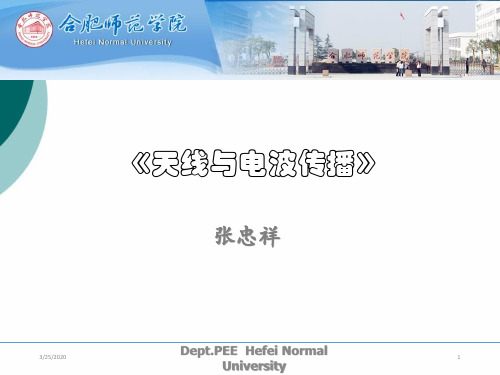
• 这时出现了分析天线公差的统计理论,发展了天线阵列的综合 理论等。
• 1957年美国研制成第一部靶场精密跟踪雷达AN/FPS-16,随后各 种单脉冲天线相继出现,同时频率扫描天线也付诸应用。
• 在50年代,宽频带天线的研究有所突破,产生了非频变天线理 论,出现了等角螺旋天线、对数周期天线等宽频带或超宽频带 天线。
天线的方向性
3/25/2020
7
Dept.PEE Hefei Normal
天线的方向性
3/25/2020
8
Dept.PEE Hefei Normal
天线的方向性
D=0.32 λ, S=0.25 λ, N=10
3/25/2020
9
Dept.PEE Hefei Normal
无线电电磁频谱
3Hz 30Hz 300Hz 3kHz 30kHz 300kHz 3MHz 30MHz 300MHz 3GHz 30GHz 300GHz 3THz 30THz 300THz
主 编:John D. Kraus
出版社:the McGraw-Hill Companies 出版时间:2002
《天线》
编著:[美]John D.Kraus Ronald J. Marhefka
出版社:电子工业出版社 2004年4月 第一版
《Radio Propagation for Modern Wireless Systems》
线电波来传递信号的,而无线电波的发射和接收都通过天线来完成。 因此天线设备是无线电系统中重要的组成部分。图1.和图2.指出了 天线设备在两种典型的无线电系统中的地位。
3/25/2020
11
Dept.PEE Hefei Normal
天线功能
• 1957年美国研制成第一部靶场精密跟踪雷达AN/FPS-16,随后各 种单脉冲天线相继出现,同时频率扫描天线也付诸应用。
• 在50年代,宽频带天线的研究有所突破,产生了非频变天线理 论,出现了等角螺旋天线、对数周期天线等宽频带或超宽频带 天线。
天线的方向性
3/25/2020
7
Dept.PEE Hefei Normal
天线的方向性
3/25/2020
8
Dept.PEE Hefei Normal
天线的方向性
D=0.32 λ, S=0.25 λ, N=10
3/25/2020
9
Dept.PEE Hefei Normal
无线电电磁频谱
3Hz 30Hz 300Hz 3kHz 30kHz 300kHz 3MHz 30MHz 300MHz 3GHz 30GHz 300GHz 3THz 30THz 300THz
主 编:John D. Kraus
出版社:the McGraw-Hill Companies 出版时间:2002
《天线》
编著:[美]John D.Kraus Ronald J. Marhefka
出版社:电子工业出版社 2004年4月 第一版
《Radio Propagation for Modern Wireless Systems》
线电波来传递信号的,而无线电波的发射和接收都通过天线来完成。 因此天线设备是无线电系统中重要的组成部分。图1.和图2.指出了 天线设备在两种典型的无线电系统中的地位。
3/25/2020
11
Dept.PEE Hefei Normal
天线功能
移动通信基站天线基础知识交流

•三、天线主要性能参数
天线增益、方向图和天线尺寸之关系
•天线增益是用来衡量天线朝一个特定方向收发信号的能力,它是选择基站天 线重要的参数之一。 天线增益越高,方向性越好,能量越集中,波瓣越窄。 增益越高,天线长度越长。
PPT文档演模板
移动通信基站天线基础知识交流
•三、天线主要性能参数
天线增益的几个要点:
(专注工作)
移动通信基站天线基础知识交流
•一、电磁波传播基础知识
多径传播:电波在传播过程中,除直接传播外,遇到障碍物(例如,山
丘、森林、地面或楼房等高大建筑物),还会产生反射和绕射。因此,到 达接收天线的电磁波,不仅有直射波,还有反射波,绕射波、透射波,这 种现象就叫多径传输。
由于多径传播使得信号场强分布复杂化,波动很大;也由于多径传输的 影响,会使电波的极化方向发生变化(扭转),因此,有的地方信号场强 增强,有的地方信号场强减弱,另外,不同的障碍物对电波的反射能力也 不同 。为降低多径传输效应的影响,一般采用空间分集或极化分集来接 收。
下零点填充 方向图圆度
移动通信基站天线基础知识交流
•三、天线主要性能参数
垂直面波束宽度及电下倾角精度:决定了网络覆盖区中距离向性能的
好坏。 观察图 3-1的垂直面方向图。波束应该适当下倾,下倾角度最好使得最大 辐射指向图3-1 中目标服务区的边缘。如果下倾太多(黄色),服务区远端的 盖电平会急剧下降;如果下倾太少,覆盖在服务区外,且产生同频干扰问题。
满足网络覆盖要求的基础指标
天线参数
水平面波束宽度、波束偏移及方向图一致性 垂直面波束宽度及电下倾角度 前后比 增益
能够提升网络通信质量的辅助指标
交叉极化比 上旁瓣抑制
PPT文档演模板
《几种常见的天线》课件

详细描述
VS
天线的作用是传输信号和接收信号,它是无线通信系统中的重要组成部分。
详细描述
天线在无线通信系统中起着非常重要的作用。它能够将电磁波转换成电流或电压,以便进行信号传输和处理。在发射端,天线将高频电流转换成电磁波并辐射出去,以便传输信号。在接收端,天线将电磁波转换成高频电流或电压,以便进行信号处理和传输。
01
02
03
缝隙天线通常由一个导电平面和一个或多个缝隙组成,缝隙的形状和尺寸决定了天线的辐射特性和方向性。
缝隙天线广泛应用于微波通信、雷达和电子对抗等领域,具有结构简单、易于制造和低成本等优点。
缝隙天线是一种利用导电平面上的开口或缝隙来辐射和接收电磁波的天线。
03
CHAPTER
天线的发展趋势和未来展望
无线电波的发现,引发了天线技术的初步探索。
19世纪末
无线电广播的兴起,促进了天线技术的进步。
20世纪初
电视、雷达等技术的发展,推动了天线技术的多样化。
20世纪中叶
无线通信技术的飞速发展,天线技术取得了重大突破。
21世纪初
A
B
C
D
04
CHAPTER
天的应用领域和案例分析
1
2
3
全向天线、定向天线、扇区天线、对数周期天线等。
通信天线种类
无线通信网络、移动通信网络、卫星通信网络等。
应用场景
手机天线、基站天线、电视接收天线等。
案例分析
固定天线、可动天线、干涉阵列等。
射电天文天线种类
射电天文观测、宇宙信号探测等。
应用场景
阿塞博天文台、射电望远镜阵列等。
案例分析
THANKS
感谢您的观看。
《几种常见的天线》ppt课件
VS
天线的作用是传输信号和接收信号,它是无线通信系统中的重要组成部分。
详细描述
天线在无线通信系统中起着非常重要的作用。它能够将电磁波转换成电流或电压,以便进行信号传输和处理。在发射端,天线将高频电流转换成电磁波并辐射出去,以便传输信号。在接收端,天线将电磁波转换成高频电流或电压,以便进行信号处理和传输。
01
02
03
缝隙天线通常由一个导电平面和一个或多个缝隙组成,缝隙的形状和尺寸决定了天线的辐射特性和方向性。
缝隙天线广泛应用于微波通信、雷达和电子对抗等领域,具有结构简单、易于制造和低成本等优点。
缝隙天线是一种利用导电平面上的开口或缝隙来辐射和接收电磁波的天线。
03
CHAPTER
天线的发展趋势和未来展望
无线电波的发现,引发了天线技术的初步探索。
19世纪末
无线电广播的兴起,促进了天线技术的进步。
20世纪初
电视、雷达等技术的发展,推动了天线技术的多样化。
20世纪中叶
无线通信技术的飞速发展,天线技术取得了重大突破。
21世纪初
A
B
C
D
04
CHAPTER
天的应用领域和案例分析
1
2
3
全向天线、定向天线、扇区天线、对数周期天线等。
通信天线种类
无线通信网络、移动通信网络、卫星通信网络等。
应用场景
手机天线、基站天线、电视接收天线等。
案例分析
固定天线、可动天线、干涉阵列等。
射电天文天线种类
射电天文观测、宇宙信号探测等。
应用场景
阿塞博天文台、射电望远镜阵列等。
案例分析
THANKS
感谢您的观看。
《几种常见的天线》ppt课件
天线设计基础ppt课件
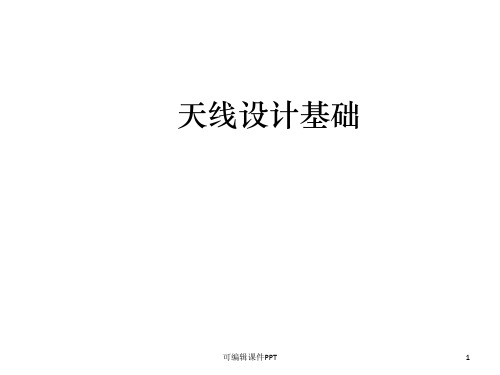
∆ 水平波瓣宽度和垂直波瓣宽度是相互影响的,其关系式 为
32400
Ga 为天线增益G;aβ为水lo平g波瓣宽度;θ为垂直波瓣宽度。
可编辑课件PPT
11
以终端设计为例
PIFA
MONOPOLE
LOOP
金属后盖
金属边框 +玻璃后盖
天线形式
馈地 电点 点
馈 电 点
馈 电 点
地 点
优点 缺点
1. 天线抗干扰 强,允许摆 放器件
D Smax S0
Pr Pro
E2 max E0 2
Pr Pro
∆ 式中Pr、Pr0分别为实际天线和无方向性 天线的辐射功率。
Radiated by Isotropic Ant. Radiated by Dipole Ant. Radiated by other Ant.
可编辑课件PPT
7
技术参数
VSWR = (1+(10^RL/20)) / ((10^RL/20)-1)
可编辑课件PPT
5
技术参数
➢ 增益 ∆ 定义为:在同一距离及相同输入功率的条件下,某天线在最大辐射方向上的辐射功率密度Smax(或场强 |Emax|2的平方)和理想无方向性天线(理想点源)的辐射功率密度S0(或场强|E0|2的平方)之比,记为 G。
G Smax S0
Pin Pin 0
E2 max E0 2
Pin Pin 0
∆ 式中Pin、Pin0分别为实际天线和理想无 方向性天线的输入功率。
∆ 理想无方向性天线本身的增益系数为1。
Radiated by Isotropic Ant. Radiated by Dipole Ant. Radiated by other Ant.
32400
Ga 为天线增益G;aβ为水lo平g波瓣宽度;θ为垂直波瓣宽度。
可编辑课件PPT
11
以终端设计为例
PIFA
MONOPOLE
LOOP
金属后盖
金属边框 +玻璃后盖
天线形式
馈地 电点 点
馈 电 点
馈 电 点
地 点
优点 缺点
1. 天线抗干扰 强,允许摆 放器件
D Smax S0
Pr Pro
E2 max E0 2
Pr Pro
∆ 式中Pr、Pr0分别为实际天线和无方向性 天线的辐射功率。
Radiated by Isotropic Ant. Radiated by Dipole Ant. Radiated by other Ant.
可编辑课件PPT
7
技术参数
VSWR = (1+(10^RL/20)) / ((10^RL/20)-1)
可编辑课件PPT
5
技术参数
➢ 增益 ∆ 定义为:在同一距离及相同输入功率的条件下,某天线在最大辐射方向上的辐射功率密度Smax(或场强 |Emax|2的平方)和理想无方向性天线(理想点源)的辐射功率密度S0(或场强|E0|2的平方)之比,记为 G。
G Smax S0
Pin Pin 0
E2 max E0 2
Pin Pin 0
∆ 式中Pin、Pin0分别为实际天线和理想无 方向性天线的输入功率。
∆ 理想无方向性天线本身的增益系数为1。
Radiated by Isotropic Ant. Radiated by Dipole Ant. Radiated by other Ant.
天线基本知识PPT课件

天线的主要电参数
1对单极化天线
方向图 增益 输入阻抗(电压驻波比) 极化 带宽 功率容量 3阶无源互调(PIM)
2 对双极化天线
除具有单极化天线的电参数 外还具有
隔离度
交叉极化比
2021
48
天线的方向图
把天线在空间辐射强度随方位、俯仰角度分布 的曲线图形叫天线方图。
天线方向图通常是一个三维空间的曲面图形。 为了表示方便起见,在工程中常用归一化方向图。
自适应天线是一种控制反馈系统它根据一定的准则采用应天线是一种控制反馈系统它根据一定的准则采用数字信号处理技术形成天线阵列的加权向量通过对接数字信号处理技术形成天线阵列的加权向量通过对接收到的信号进行加权合并在有用信号方向上形成主波收到的信号进行加权合并在有用信号方向上形成主波束而在干扰方向上形成零陷从而提高信号的输出信束而在干扰方向上形成零陷从而提高信号的输出信多波束天线采用多个波束覆盖整个用户区每个波束的多波束天线采用多个波束覆盖整个用户区每个波束的指向固定波束宽度随天线阵元数目的确定而确定系指向固定波束宽度随天线阵元数目的确定而确定系统根据用户的空间位臵选取相应的波束使接收的信号统根据用户的空间位臵选取相应的波束使接收的信号最佳
对无线通信系统也同样是这样。再先进的基站通信设 备,没有好的天线,也无法发挥优良的性能。可见天线是 无线通信系统的重要组成部分。
2021
43
天线的作用
将传输线中的高频电磁能量转成为自由空间的电磁波 ,或反之将自由空间中的电磁波转化为传输线中的高频电 磁能。因此,要了解天线的特性就必然需要了解自由空间 中的电磁波及高频传输线的一些相关的知识。
2021
22
E(r,,)
若天线辐射的电场强度为
把电场强E(r度,,()绝6对0f值(,)) 写成
天线PPT课件(完整版)
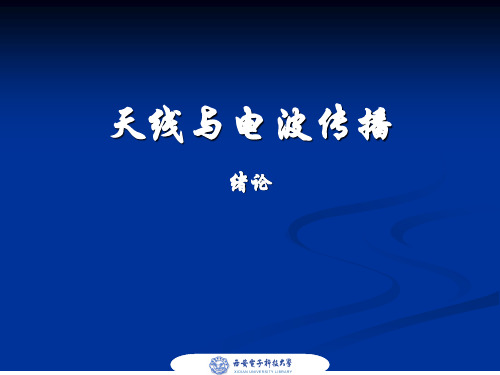
10
电磁频谱与无线电频段
天线概念
天线是无线系统的重要部件,它是现代信息社会的电子眼、 电子耳。 定义 — 用来辐射或接收无线电波的装置,导行波与自由空 间波互相转换区域的结构,转换器件或换能器 — 能量转换。 电路的观点 — 从传输线看向天线这一段等效于一个电阻 Rr , 是从空间耦合到天线终端的电阻,与天线结构自身的任何电阻 无关。
7
天线发展简史
三、1980, 超大阵列(VLA)抛物面天线(Very Large Array Steerable Parabolic Dish Antennas) 位于美国新墨西哥州(Socorro, New Mexico)的超大阵 列天线由27面直径为25米的抛物面按Y型方式排列组成,是 世界第一个射电天文望远镜。其分辨率相当于36千米跨度的 天线,而灵敏度相当于直径为130米的碟型天线。
1 H A
A
因此,知道
A
1 E jA jA j A
§1.1 辅助函数法
A 4 e jkR J x, y , z dv -体电流 R v e jkR J s x, y , z ds -面电流 R s e jkR I e x, y, z dl R c
天线发展简史
五、2000, 移动/手持天线(Mobile/Hand - held Antenna) 工作于800MHz的手持蜂窝电话天线随处可见。 从马可尼时代直到20世纪40年代,天线主要是以 导线为辐射单元,工作频率也提高到UHF。 进入二战期间,随着1GHz以上微波源(如调速 管、磁控管)的发明,天线开始了一个新的纪元。 波导口径天线、喇叭天线和反射面天线等如雨后春 笋般出现。
天线基础知识与原理ppt课件
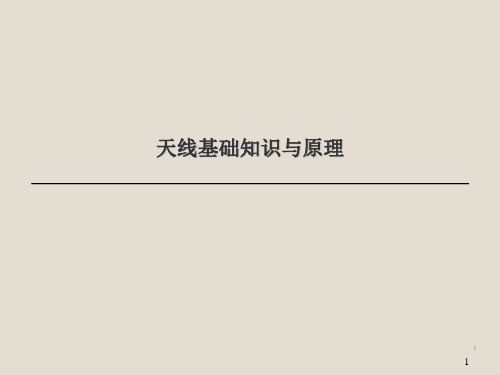
振子结构相对复杂,加工 难度较大;特别是合金压铸 方式的半波振子。 成本较高。
微带贴片
振子形式简单,易于冷冲压 成型; 易于与微带功率分配网络一 体化设计; 成本相对较低。
交叉极化指标较差; 双极化贴片天线的极化隔 离度较差; 装配精度要求较高
8
2、天线类型及各部件材质介绍---天线振子
常
规
套
全
筒 振
向
子
天
移
线
动
缩 短 套
通
筒
信
振 子
天
线
半
类
波
型
定
向
振 子
天
线
微
带
贴
片
高性能 一般型 高性能 一般型
7
2、天线类型及各部件材质介绍---天线振子
半波振子VS微带贴片
振子形式
半波振子
优点
缺点
辐射效率高、交叉极化指标 较好; 单元辐射阻抗较易优化; 实现形式多样化,可采用印 制板、金属板冷冲压、锌合金 压铸等多种实现方式。
垂直面 E面
水平面波束宽度 = 360º 垂直面波束宽度= 78º
立体图
15
3、天线原理及指标介绍---方向图
将“轮胎”压扁,信号就越集中,实际使用的天线就是采用一个或者多 个辐射单元来实现的。
16
3、天线原理及指标介绍---辐射参数
辐射参数:
辐射参数评估:
--- 按重要性顺序排列
水平面波束宽度 电下倾角度 垂直面波束宽度 前后比 增益
较好
玻璃钢
2.3 1.2 差 -70℃~+150℃ 240 219 10110 UL94V-0 好 较好 好
第1章--天线基础知识
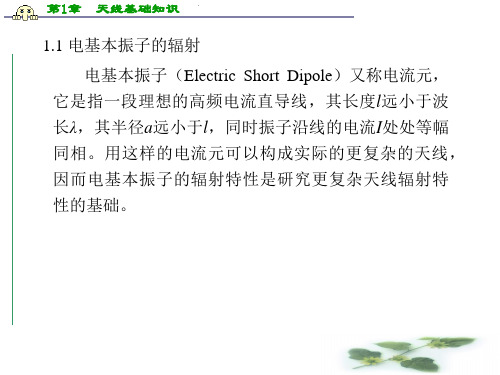
f ( , ) f ( ) l sin
第1章 天线基础知识
为了便于比较不同天线的方向性,常采用归一化 方向函数,用F(θ,φ)表示,即
F( , )
f ( , )
E( , )
fmax ( , )
Emax
第1章 天线基础知识
式中,fmax(θ,φ)为方向函数的最大值;Emax为最大辐射方 向上的电场强度;E(θ,φ)为同一距离(θ,φ)方向上的电场强 度。
归一化方向函数F(θ,φ)的最大值为1。因此,电基本 振子的归一化方向函数可写为
F(θ,φ)=|sinθ| 为了分析和对比方便,今后我们定义理想点源是无 方向性天线,它在各个方向上、相同距离处产生的辐射 场的大小是相等的,因此,它的归一化方向函数为
F(θ,φ)=1
第1章 天线基础知识
1.2.2 方向图 天线的方向函数,它与r及I无关。将方向函数用
y
图1―2―3 电基本振子E平面方向图
第1章 天线基础知识
z
x
y |sin 90°|= 1
图1―2―4 电基本振子H平面方向图
第1章 天线基础知识
但是要注意的是,尽管球坐标系中的磁基本振子方 向性和电基本振子一样,但E面和H面的位置恰好互换。
有时还需要讨论辐射的功率密度(坡印廷矢量模值) 与方向之间的关系,因此引进功率方向图(Power Pattern)Φ(θ,φ)。容易得出,它与场强方向图之间的关 系为
第1章 天线基础知识 z
Er
H
Ir
E
lO y
x
图1―1 电基本振子的坐标
第1章 天线基础知识
E Erer E e
H He
式中,E为电场强度,单位为V/m;
H为磁场强度,单位为A/m;
第1章 天线基础知识
为了便于比较不同天线的方向性,常采用归一化 方向函数,用F(θ,φ)表示,即
F( , )
f ( , )
E( , )
fmax ( , )
Emax
第1章 天线基础知识
式中,fmax(θ,φ)为方向函数的最大值;Emax为最大辐射方 向上的电场强度;E(θ,φ)为同一距离(θ,φ)方向上的电场强 度。
归一化方向函数F(θ,φ)的最大值为1。因此,电基本 振子的归一化方向函数可写为
F(θ,φ)=|sinθ| 为了分析和对比方便,今后我们定义理想点源是无 方向性天线,它在各个方向上、相同距离处产生的辐射 场的大小是相等的,因此,它的归一化方向函数为
F(θ,φ)=1
第1章 天线基础知识
1.2.2 方向图 天线的方向函数,它与r及I无关。将方向函数用
y
图1―2―3 电基本振子E平面方向图
第1章 天线基础知识
z
x
y |sin 90°|= 1
图1―2―4 电基本振子H平面方向图
第1章 天线基础知识
但是要注意的是,尽管球坐标系中的磁基本振子方 向性和电基本振子一样,但E面和H面的位置恰好互换。
有时还需要讨论辐射的功率密度(坡印廷矢量模值) 与方向之间的关系,因此引进功率方向图(Power Pattern)Φ(θ,φ)。容易得出,它与场强方向图之间的关 系为
第1章 天线基础知识 z
Er
H
Ir
E
lO y
x
图1―1 电基本振子的坐标
第1章 天线基础知识
E Erer E e
H He
式中,E为电场强度,单位为V/m;
H为磁场强度,单位为A/m;
天线理论基础知识 ppt课件

➢辐射单元各组成部分的尺寸精 度和相对位置精度;
➢板材的质量和强度; ➢表面处理质量。
➢塑料件的尺寸精度、结构强 度和抗老化性能;
➢馈电方式及馈电片与振子的 相对位置精度。 17
二、天线质量分析、选型及安装
天线质量分析:馈电网络
馈电网络
同轴电缆馈电网络
PCB微带线馈电网络
空气微带线馈电网络
图例
特点分析
➢焊点多,焊接质量控制是关键;
加盖板整体屏蔽,此时则衍变为PCB 稳定性,受反射板变形影响大,导致幅
➢布线工艺较复杂。
带状线馈电网络;
度和相位分配精度低,尺寸稳定性差,
➢PCB与反射板需绝缘处理;
批量一致性差;
➢优质板材成本较高。
➢设计自由度较大,辐射泄漏大,可增
加盖板整体屏蔽,此时则衍变为空气带
状线馈电网络。
三阶、五阶都不落入到Rx频段
联通LTE1.8G
1830-1859 1735-1764
1801~1888
1772~1917
三阶、五阶都不落入到Rx频段
联通WCDMA 2130~2145 1940~1955
2115~2160
2100~2175
三阶、五阶都不落入到Rx频段
12
一、天线原理及指标对网络质量的影响
➢加工精度高,幅度和相位分配精度 ➢加工精度高,幅度和相位分配精度高, ➢多个零件拼装组成,网络与反射板之
高,尺寸稳定性好,批量一致性好; 尺寸稳定性好,批量一致性好;
间的距离精度要求高,且主要通过塑料
➢设计自由度一般,辐射泄漏极低; ➢设计自由度大,辐射泄漏较大,可增 件和孔位精度配合保持尺寸精度和结构
如何预防天线质量问题&提升网络效率创 新解决方案的探讨
手机天线设计讲义

喷涂
在天线表面喷涂一层绝缘材料,以提高天线的辐射效率和防止电磁 干扰。
抗氧化处理
在金属表面形成一层抗氧化膜,提高天线的耐候性和使用寿命。
04 手机天线测试与优化
天线性能测试
辐射性能测试
包括天线增益、波束宽度、前后比等,用于 评估天线辐射效果。
阻抗匹配测试
检查天线输入阻抗与传输线阻抗是否匹配, 以降低信号反射。
多频段兼容
支持多种通信频段,满足不同 运营商和地区的需求。
尺寸与重量
合理控制天线尺寸和重量,以 适应手机整体设计。
耐用性与可靠性
确保天线在各种环境和使用条 件下都能稳定工作。
02 手机天线设计流程
设计准备
需求分析
明确手机天线设计的需求,包括 性能指标、应用场景和限制条件
等。
技术调研
了解当前手机天线设计的技术现状 和发展趋势,为后续设计提供参考。
制定计划
根据需求和技术调研结果,制定详 细的设计计划,包括时间安排、人 员分工和预期成果等。
方案设计
初步方案
根据需求和技术调研结果,制定 初步的手机天线设计方案,包括 天线类型、尺寸、性能指标等。
方案评估
对初步方案进行评估,分析其可 行性和优缺点,并提出改进意见。
方案优化
根据评估结果,对初步方案进行 优化,提高其可行性和性能。
效率测试
测量天线传输效率,确保天线能量有效传输。
方向图测试
通过测量天线在不同角度的辐射强度,得到 天线方向图,评估天线覆盖范围。
优化方法
调整天线尺寸
改变天线结构参数,如振子长度、宽 度和间距等,以改善天线性能。
选用高性能材料
使用导电性能良好的材料,如铜、银 等,提高天线效率。
在天线表面喷涂一层绝缘材料,以提高天线的辐射效率和防止电磁 干扰。
抗氧化处理
在金属表面形成一层抗氧化膜,提高天线的耐候性和使用寿命。
04 手机天线测试与优化
天线性能测试
辐射性能测试
包括天线增益、波束宽度、前后比等,用于 评估天线辐射效果。
阻抗匹配测试
检查天线输入阻抗与传输线阻抗是否匹配, 以降低信号反射。
多频段兼容
支持多种通信频段,满足不同 运营商和地区的需求。
尺寸与重量
合理控制天线尺寸和重量,以 适应手机整体设计。
耐用性与可靠性
确保天线在各种环境和使用条 件下都能稳定工作。
02 手机天线设计流程
设计准备
需求分析
明确手机天线设计的需求,包括 性能指标、应用场景和限制条件
等。
技术调研
了解当前手机天线设计的技术现状 和发展趋势,为后续设计提供参考。
制定计划
根据需求和技术调研结果,制定详 细的设计计划,包括时间安排、人 员分工和预期成果等。
方案设计
初步方案
根据需求和技术调研结果,制定 初步的手机天线设计方案,包括 天线类型、尺寸、性能指标等。
方案评估
对初步方案进行评估,分析其可 行性和优缺点,并提出改进意见。
方案优化
根据评估结果,对初步方案进行 优化,提高其可行性和性能。
效率测试
测量天线传输效率,确保天线能量有效传输。
方向图测试
通过测量天线在不同角度的辐射强度,得到 天线方向图,评估天线覆盖范围。
优化方法
调整天线尺寸
改变天线结构参数,如振子长度、宽 度和间距等,以改善天线性能。
选用高性能材料
使用导电性能良好的材料,如铜、银 等,提高天线效率。
- 1、下载文档前请自行甄别文档内容的完整性,平台不提供额外的编辑、内容补充、找答案等附加服务。
- 2、"仅部分预览"的文档,不可在线预览部分如存在完整性等问题,可反馈申请退款(可完整预览的文档不适用该条件!)。
- 3、如文档侵犯您的权益,请联系客服反馈,我们会尽快为您处理(人工客服工作时间:9:00-18:30)。
3
介质
• 介电常数εr>=1.真空的介电常数为1. • 介电常数越大,波长就越短. • 选择高介电常数的介质可以减小天线的空
间. 但是会造成带宽比较窄,能量储存在介质 中,不利于能量的有效辐射.
4
Return Loss 和VSWR
• RTL=10log(Pout/Pin)=10logГ^2 • VSWR=(1+Г)/(1-Г)
15
Number ONE rule (首要规则)
• When designing any kind of small antenna for the mobile phone, it’s important to start designing the antenna TOGETHER with the antenna manufacturer in very early state to achieve the best possible performance, and when concerning internal antennas this is even MORE important
• TD-SCDMA 1880-1920MHz、2010-2025MHz
•
2300-2400MHz
2
电磁波
• 电磁波通常ห้องสมุดไป่ตู้的就是无线电波,它是以光的 速度传播.
• V=λ*f (v: 速度, λ: 波长 f: 频率)
例如: 900Mhz 的波长: λ= V/F =3*10^8/9*10^8=0.33m=33cm
• (请密切注意天线的高度(发射片和接地 片的距离) <=> 带宽)
18
Rule No. 4 (规则 4)
• Also the length of the chassis has a remarkable effect on the performance of the antenna
• 手机的长度对于天线的性能有着显著的影响
(Г为反射系数) 例如: VSWR=3,
Г=0.5, RTL=10logГ^2=-6.
5
RTL 和VSWR 对应表
6
天线效率
• 天线效率是指有效输出功率和输入功率的 比值.
• Eff=Pr/Pt. (Pr 是辐射功率,Pt是总的输入功 率)
7
GAIN,EFF,Directivity
• GAIN: 天线的增益,一般用dB来表示. • Directivity: 天线的方向性. • G=EFF*D
• (在设计任何种类的移动电话天线时,为了得到 尽可能最好的性能,和天线制造商在最初阶段一 起开始设计天线是很重要的,这对于内置天线来 说尤为重要。)
16
Rule No. 2 (规则 2)
• Use all space you have: BIG size is beautiful when concerning antenna’s performance
• 天线会越来越多.(BT,FM,WIFI,AM, RFID,WIMAX,DVB等)
• 测试的项目会越来越多 (TRP,TIS,EMC,ESD,EMI等)
• SAR 和HAC的测试会越来越普及. • 测试标准---CTIA.
11
G pattern
• 典型的形状如下:
12
手机天线设计要领
13
How to design a GOOD internal antenna?
9
SAR
• SAR: Specific Absorption Rate • SAR是用来测量有多少能量被人体组织吸收. • 是用一种特定的系统来测量.(DASY 3,DASY4) • 一般是是以1g或10g的大小为单位来测量. • 欧洲对SAR的要求是2.0W/KG,美洲为
1.6W/KG.
10
功能测试的趋势和标准
8
TRP,EIRP,TIS,EIS
• TRP: Total Radiated Power. • EIRP: Effective isotropic Radiated Power • TIS: Total Isotropic Sensitivity • EIS: Effective Isotropic Sensitivity.
• Locate feeding and short circuiting pads near the edge of the ground plane (phone’s PCB). For spring contacts the distance between bending point and PCB-pad should be 4…5 mm.
如何设计一个好的内置天线
14
PIFA
• short circuited <=> /4 resonator <=> compact structure • (短接电路 <=> /4 谐振片<=>紧凑的结构) • omnidirectional in horizontal plane • (水平面的全方向性) • co- and crosspolarisations • (同向和交叉极化) • Multiresonant • (多谐的)
• (使用尽可能多的空间: 对于天线的性能 来讲, 尺寸越大越好。)
17
Rule No. 3 (规则 3)
• Pay special attention to antenna’s height (distance between radiator and ground) <=> BANDWIDTH!
天线基础知识
1
什么是天线?
• 天线是用来接收发射电磁波的设备.
• 它工作在一个相对比较窄的频段范围内.
• 900频段 880M-960M 1800频段1710M-1880M
• 850频段 824M-894M 1900频段1850M-1990M
• CDMA800 824M-894M
• WCDMA 1920-1980MHz/2110-2170MHz
19
Rule No. 5 (规则 5)
• Keep ALL metals as far as possible from the antenna, at least as far as ground plane is
• (所有的金属应尽可能的远离天线,至少象接地 片一样远。)
20
Rule No. 6 (规则 6)
介质
• 介电常数εr>=1.真空的介电常数为1. • 介电常数越大,波长就越短. • 选择高介电常数的介质可以减小天线的空
间. 但是会造成带宽比较窄,能量储存在介质 中,不利于能量的有效辐射.
4
Return Loss 和VSWR
• RTL=10log(Pout/Pin)=10logГ^2 • VSWR=(1+Г)/(1-Г)
15
Number ONE rule (首要规则)
• When designing any kind of small antenna for the mobile phone, it’s important to start designing the antenna TOGETHER with the antenna manufacturer in very early state to achieve the best possible performance, and when concerning internal antennas this is even MORE important
• TD-SCDMA 1880-1920MHz、2010-2025MHz
•
2300-2400MHz
2
电磁波
• 电磁波通常ห้องสมุดไป่ตู้的就是无线电波,它是以光的 速度传播.
• V=λ*f (v: 速度, λ: 波长 f: 频率)
例如: 900Mhz 的波长: λ= V/F =3*10^8/9*10^8=0.33m=33cm
• (请密切注意天线的高度(发射片和接地 片的距离) <=> 带宽)
18
Rule No. 4 (规则 4)
• Also the length of the chassis has a remarkable effect on the performance of the antenna
• 手机的长度对于天线的性能有着显著的影响
(Г为反射系数) 例如: VSWR=3,
Г=0.5, RTL=10logГ^2=-6.
5
RTL 和VSWR 对应表
6
天线效率
• 天线效率是指有效输出功率和输入功率的 比值.
• Eff=Pr/Pt. (Pr 是辐射功率,Pt是总的输入功 率)
7
GAIN,EFF,Directivity
• GAIN: 天线的增益,一般用dB来表示. • Directivity: 天线的方向性. • G=EFF*D
• (在设计任何种类的移动电话天线时,为了得到 尽可能最好的性能,和天线制造商在最初阶段一 起开始设计天线是很重要的,这对于内置天线来 说尤为重要。)
16
Rule No. 2 (规则 2)
• Use all space you have: BIG size is beautiful when concerning antenna’s performance
• 天线会越来越多.(BT,FM,WIFI,AM, RFID,WIMAX,DVB等)
• 测试的项目会越来越多 (TRP,TIS,EMC,ESD,EMI等)
• SAR 和HAC的测试会越来越普及. • 测试标准---CTIA.
11
G pattern
• 典型的形状如下:
12
手机天线设计要领
13
How to design a GOOD internal antenna?
9
SAR
• SAR: Specific Absorption Rate • SAR是用来测量有多少能量被人体组织吸收. • 是用一种特定的系统来测量.(DASY 3,DASY4) • 一般是是以1g或10g的大小为单位来测量. • 欧洲对SAR的要求是2.0W/KG,美洲为
1.6W/KG.
10
功能测试的趋势和标准
8
TRP,EIRP,TIS,EIS
• TRP: Total Radiated Power. • EIRP: Effective isotropic Radiated Power • TIS: Total Isotropic Sensitivity • EIS: Effective Isotropic Sensitivity.
• Locate feeding and short circuiting pads near the edge of the ground plane (phone’s PCB). For spring contacts the distance between bending point and PCB-pad should be 4…5 mm.
如何设计一个好的内置天线
14
PIFA
• short circuited <=> /4 resonator <=> compact structure • (短接电路 <=> /4 谐振片<=>紧凑的结构) • omnidirectional in horizontal plane • (水平面的全方向性) • co- and crosspolarisations • (同向和交叉极化) • Multiresonant • (多谐的)
• (使用尽可能多的空间: 对于天线的性能 来讲, 尺寸越大越好。)
17
Rule No. 3 (规则 3)
• Pay special attention to antenna’s height (distance between radiator and ground) <=> BANDWIDTH!
天线基础知识
1
什么是天线?
• 天线是用来接收发射电磁波的设备.
• 它工作在一个相对比较窄的频段范围内.
• 900频段 880M-960M 1800频段1710M-1880M
• 850频段 824M-894M 1900频段1850M-1990M
• CDMA800 824M-894M
• WCDMA 1920-1980MHz/2110-2170MHz
19
Rule No. 5 (规则 5)
• Keep ALL metals as far as possible from the antenna, at least as far as ground plane is
• (所有的金属应尽可能的远离天线,至少象接地 片一样远。)
20
Rule No. 6 (规则 6)
